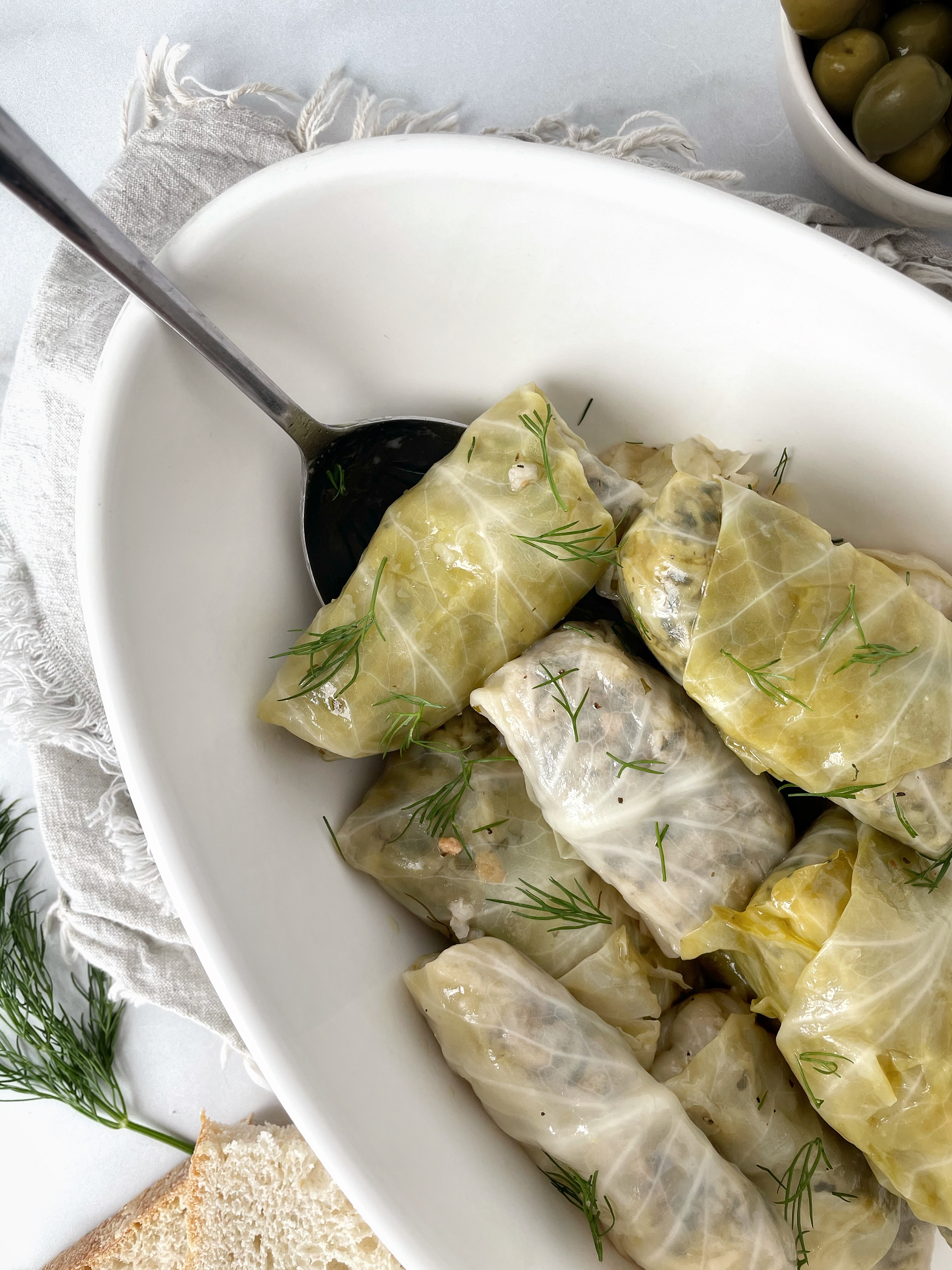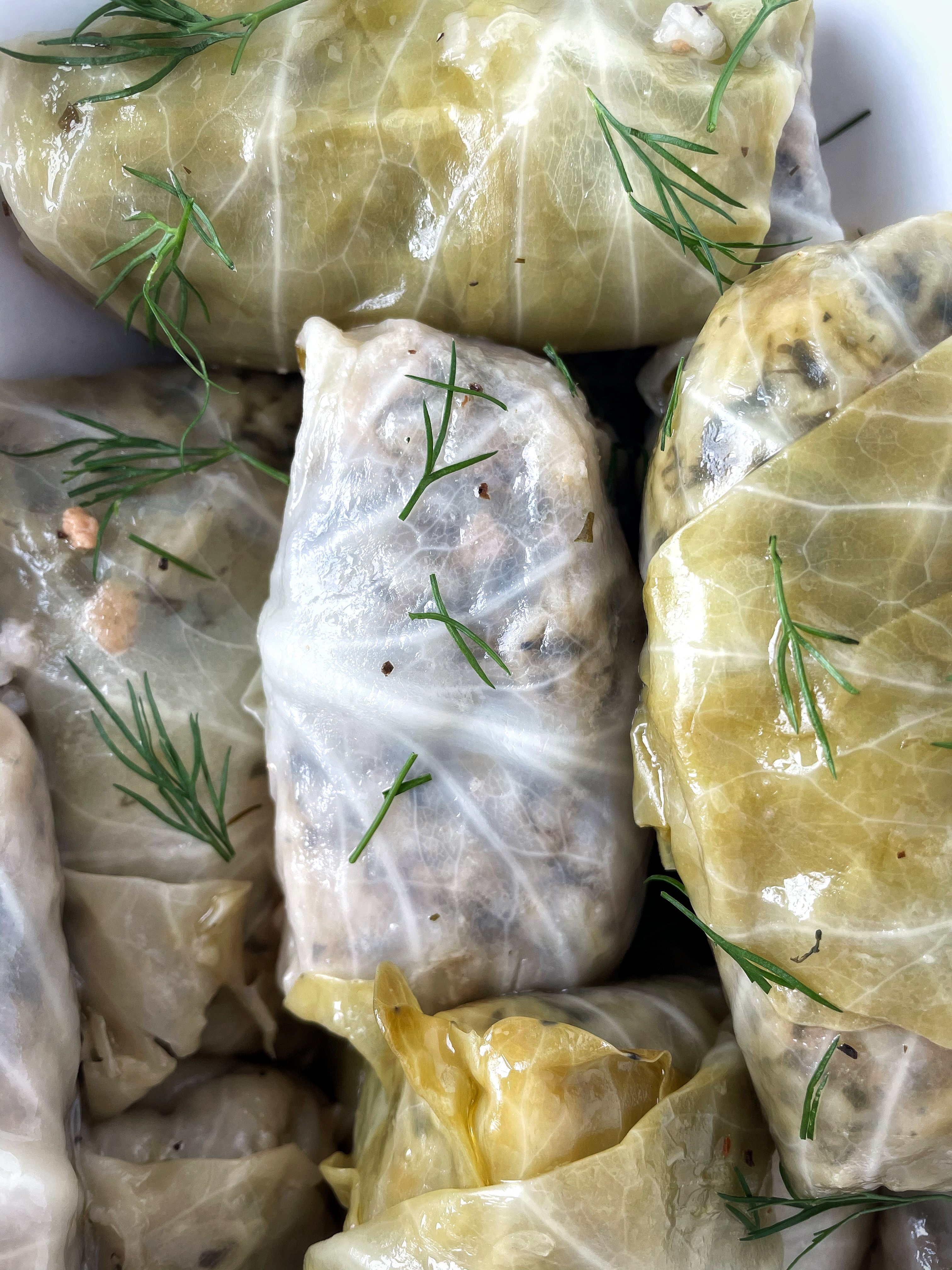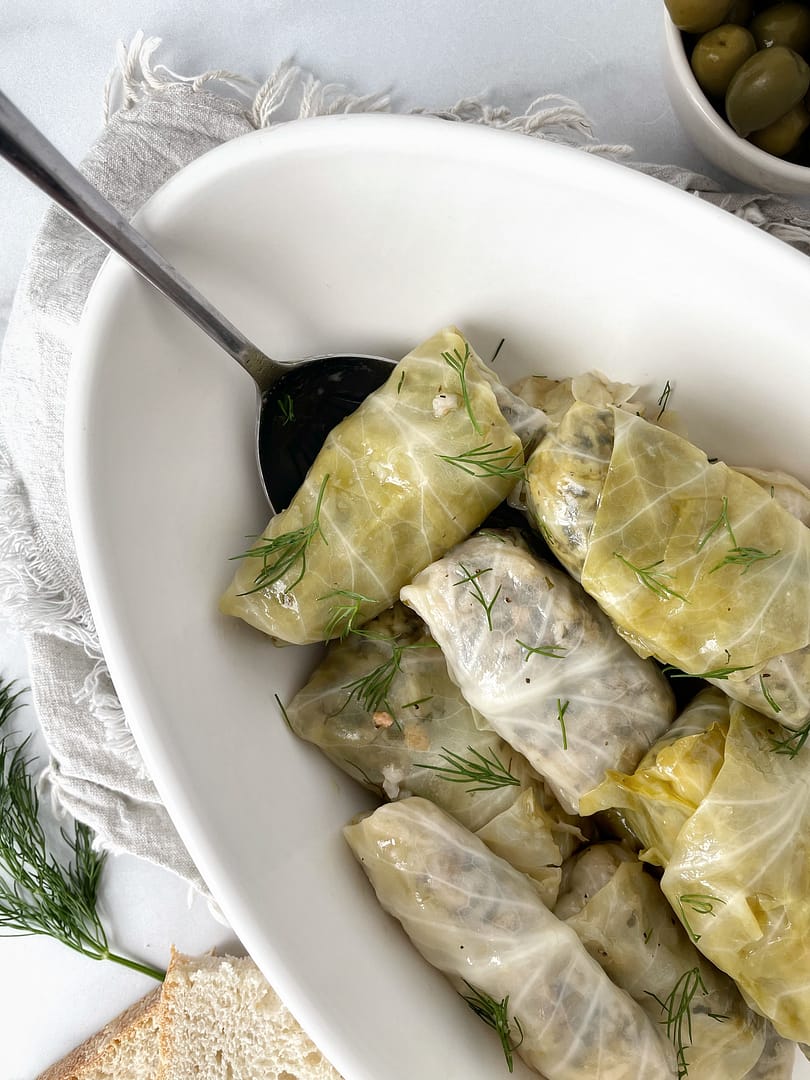This classic dish is getting a modern vegan makeover! Instead of ground beef, these Greek-style stuffed cabbage rolls use your favorite plant-based meat alternative, paired with rice and herbs for a dish that’s balanced and filling.

Laxano dolmades – or Greek-style stuffed cabbage rolls – are a traditional Greek dish usually made with ground beef, rice, herbs, and topped off with an egg lemon sauce. I’ll be honest, when I was first attempting to “veganize” this dish, I was a little intimidated myself. Not only would I be replacing the ground beef, but I also would be replacing the egg lemon sauce, avgolemono. A very ambitious goal indeed.
It took me several tries to get this right as I have been experimenting and trying various plant-based meats over the last eighteen months. Not all meat alternatives are equal in taste and texture (and ingredients)! However, replacing the ground beef was definitely the easier part. In fact, the trickiest part of this, was finding a way to replicate the egg lemon sauce. Traditionally, egg whites are whipped and beat until fluffy and puffy. Then they’re mixed with lemon and the broth from the cabbage. Finally, the sauce is poured back into the pot, covering the cabbage rolls. Even as it cools, the egg lemon sauce doesn’t break down. It stays thick and full-bodied. In the attempt to veganize this dish, upholding the texture of the sauce was definitely the hardest part.
There are several parts to creating this dish. Let’s break them down below.
The 5 Steps to Making Stuffed Cabbage Rolls
There are 5 main steps to making the perfect Greek-style stuffed cabbage rolls and I’m going to go through them one by one in this section.
1. Prepare the Cabbage
The first segment to this dish is preparing the cabbage. There are 3 steps in this section.
First, you core the cabbage. Cut out the core of the cabbage with a sharp knife, about an inch wide and about 1-2 inches deep, angling towards the center of the cabbage. Don’t go too wide or too deep – we want to keep the cabbage leaves in tact.
Second, set a big pot of water to boil with a tablespoon or two of vinegar. The vinegar helps neutralize the odor of the boiling cabbage so that your entire house doesn’t smell as much.
Third, you boil the cabbage, core side up. As the cabbage boils, the outer leaves will soften so that you can easily peel them off and set them aside. I typically use a pitchfork like utensil to hold the cabbage in one hand and tongs in the other hand to gently peel the cabbage leaves off. The leaves should simply fall off with the assist of the tongs. If you have to pull, the leaves are not soft enough and require additional boiling.
Boil and peel the leaves until the entire cabbage is bare. Set the cabbage leaves on a plate or platter and put aside to cool. Save the water in this pot for the cooking portion.

2. Prepare the filling
In a skillet, you’ll be sauteing onions, garlic, the plant-based meat alternative, herbs and rice with some olive oil. The point of this is to soften the rice and help incorporate the flavors together in the filling. The point is not to cook the rice all the way.
3. Roll the cabbage leaves and filling
The concept of rolling up the cabbage leaves is the same as rolling grape leaves, burritos, spring rolls, etc. If you need a visual, here’s a youtube video I made for rolling! Typically, it’s one heaping tablespoon of filling for each cabbage roll. The outer, larger leaves may need 2-3 tablespoons and the smaller, inner leaves made need 1 scant tablespoon.
Remember that less is more. As the rice cooks, it will absorb the water and enlarge. If you have too much filling, the rolls can burst out or unravel as the rice cooks and gets bigger.
Place the filling towards the bottom of the leaf. Roll over once from the bottom. Tuck the sides over and then continue to roll tightly.
4. Cook the cabbage rolls
As you roll the cabbage leaves, you position them tightly against each other in a big pot. You can lay next to each other snugly and then on top of each other until you’ve used up all the cabbage and filling. Any extra leaves can line the bottom of the pot or be tucked in between the rolls.
Take the water that you saved from boiling the cabbage and pour it into the pot of cabbage leaves until the rolls are just covered.
Then, and this is important, place a dinner plate on top of the cabbage rolls. If you don’t have a small enough plate, use a heavy heat-safe bowl. The dinner plate will hold the grape leaves down as they are boiling, preventing them rising and unfolding. A lid for your pot will not work as it only covers the pot, it does not hold down the cabbage rolls. Once the water is boiling, reduce the heat to medium-low and simmer for forty five minutes.
5. Prepare the sauce
The Ingredients
When there is ten minutes left of cooking, it’s time to prepare the sauce. As I mentioned before, the traditional sauce is an egg lemon sauce. In this case, we’re swapping the egg whites with aquafaba and we’re using a stabilizer and thickener to help with the texture of the sauce.
Aquafaba is the liquid from a can of chickpeas. The stabilizer (to help keep the aquafaba keep it’s shape) is cream of tartar. The thickener is a wee bit of corn or arrowroot starch. We require the starch to help provide a bit of a fuller body that the eggs normally have.
The Process
First, you’ll start by lightly beating the aquafaba in a big bowl with a hand mixer. Next, when it starts to foam, you’ll add the cream of tartar and beat at high speed for about 5-6 minutes. The aquafaba will whip and become puffy like egg whites.
Once the aquafaba is whipped, you’ll set that aside and prepare the last portion of this sauce. You’ll squeeze the lemons and then whisk one tablespoon of starch into the lemon juice. Once it’s fully combined, you’ll pour that into the bowl of whipped aquafaba.
The Last Step
Lastly, once the cabbage rolls are done cooking (and you’ve tried the inside of one of the rolls to make sure the rice is done), we combine everything together.
Turn off the heat, keep the dinner plate in place and carefully drain the broth from a pot into a measuring cup. Once most of the broth has been poured out, you can set the pot aside and remove the dinner plate. Next, grab a whisk in your dominant hand. With your other hand, slowly start pouring the broth into the bowl of aquafaba while continuously whisking with the dominant hand. Do this until all the broth is whisked in and combined. Then, pour the bowl of aquafaba and broth back into the pot over the cabbage rolls.
Finally, you are ready to eat!
I know that there are a lot of steps to this dish and I tried to be as detailed and thorough as possible in crafting this post. While these steps might seem daunting, I promise that it’s totally worth it and just like everything, cooking takes practice.
Not every Greek dish is this lengthy – there are other simpler dishes in Greek cuisine. If you’re in the mood for something a bit easier, check out these other Greek dishes:
However, if you’re ambitious, are feeling prepared and want the cozy and filling Greek-style stuffed cabbage rolls, then I say: give it a shot!
Greek-style Stuffed Cabbage Rolls – Laxano Dolmades
Equipment
- Hand Mixer
Ingredients
- 1 large green cabbage
- 1 tablespoon vinegar
- 1 lb plant-based ground "beef" or meat alternative
- 1 cup white rice jasmine or basmati
- 1 large onion
- 3 cloves of garlic, minced
- 1/4 cup olive oil
- 2 cups fresh parsley leaves chop after measuring
- 1/3 cup chopped fresh dill
- 1/3 cup fresh chopped mint
- salt and pepper to taste
- 2 tablespoons oregano
- 1 cup water
The Lemon Sauce
- 1/3 cup aquafaba
- 1 1/2 lemons juiced
- 1/4 tsp cream of tartar
- 1 tbsp corn starch
Instructions
- Set a large pot of water and vinegar to boil.
- While the water is heating, core the cabbage. Cut out the core of the cabbage with a sharp knife, about an inch wide and about 1-2 inches deep, angling towards the center of the cabbage. Don't go too wide or too deep – we want to keep the cabbage leaves in tact.
- Boil the cabbage, core side up. As the cabbage boils, the outer leaves will soften so that you can easily peel them off and set them aside. If you have to pull, the leaves are not soft enough and require additional boiling. Boil and peel the leaves off the whole cabbage. Set the leaves aside to cool. Save the water and set aside.
- As the cabbage is boiling, dice the onion and garlic and add to a skillet with olive oil. Saute over medium high heat until softened and translucent.
- Then add the plant-based ground "beef" and saute, spices and herbs until well incorporated.
- Add the rice and one cup of water. Saute for just a minute or two or until the water has been absorbed. Turn off the heat and set the filling aside.
- Next, fill and roll the cabbage leaves. Add a tablespoon of filling towards the bottom of the leaf. Roll once from the bottom up. Then fold over the sides. Then continue rolling up tightly like a burrito.
- Line a big pot with unused cabbage leaves. Then layer the cabbage rolls tightly against and on top of one another. Add the hot water from before until the cabbage rolls are just covered. Then place a dinner plate on top of the cabbage rolls.
- Bring the cabbage rolls to a boil. Then reduce the heat to medium-low and simmer for 45 minutes with the dinner plate on top of the leaves.
Making the Lemon Sauce
- When there's ten minutes left of cooking time, prepare the sauce. Begin by adding the aquafaba to a big bowl and beat with a hand mixer. Once the aquafaba starts to get foamy, add the cream of tartar and then beat on high until fluffy, about 5-6 minutes.
- Juice the lemon and whisk the cornstarch into the lemon juice. Then add that to the bowl of aquafaba.
- Once the cabbage leaves have finished cooking, drain the broth from the pot into a measuring cup. Set the pot aside and remove the dinner plate.
- With one hand, pour the broth slowly into the bowl of aquafaba and with the other hand, whisk at the same time. Whisk until the broth has been fully emptied into the aquafaba.
- Pour the aquafaba sauce over the cabbage rolls and then drizzle the cabbage rolls with olive oil, salt and pepper.
- Gently scoop out the rolls and some broth onto a plate and serve. Top with fresh dill if desired.
Did you make this? Leave a comment below and share a picture on Instagram with the hashtag #thewholescoopblog





